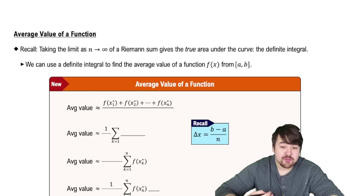Explain how to apply the First Derivative Test.
Table of contents
- 0. Functions7h 54m
- Introduction to Functions16m
- Piecewise Functions10m
- Properties of Functions9m
- Common Functions1h 8m
- Transformations5m
- Combining Functions27m
- Exponent rules32m
- Exponential Functions28m
- Logarithmic Functions24m
- Properties of Logarithms36m
- Exponential & Logarithmic Equations35m
- Introduction to Trigonometric Functions38m
- Graphs of Trigonometric Functions44m
- Trigonometric Identities47m
- Inverse Trigonometric Functions48m
- 1. Limits and Continuity2h 2m
- 2. Intro to Derivatives1h 33m
- 3. Techniques of Differentiation3h 18m
- 4. Applications of Derivatives2h 38m
- 5. Graphical Applications of Derivatives6h 2m
- 6. Derivatives of Inverse, Exponential, & Logarithmic Functions2h 37m
- 7. Antiderivatives & Indefinite Integrals1h 26m
- 8. Definite Integrals4h 44m
- 9. Graphical Applications of Integrals2h 27m
- 10. Physics Applications of Integrals 3h 16m
- 11. Integrals of Inverse, Exponential, & Logarithmic Functions2h 31m
- 12. Techniques of Integration7h 41m
- 13. Intro to Differential Equations2h 55m
- 14. Sequences & Series5h 36m
- 15. Power Series2h 19m
- 16. Parametric Equations & Polar Coordinates7h 58m
5. Graphical Applications of Derivatives
Intro to Extrema
Problem 4.8
Textbook Question
In Exercises 1–10, find the extreme values (absolute and local) of the function over its natural domain, and where they occur.
__________
y = √ 3 + 2𝓍 ―𝓍²
 Verified step by step guidance
Verified step by step guidance1
Identify the function: \( y = \sqrt{3 + 2x - x^2} \). The domain of this function is determined by the expression inside the square root being non-negative, i.e., \( 3 + 2x - x^2 \geq 0 \).
Find the critical points by first determining the derivative of the function. Use the chain rule to differentiate \( y = \sqrt{3 + 2x - x^2} \).
Set the derivative equal to zero to find critical points. Solve the equation \( \frac{dy}{dx} = 0 \) to find the values of \( x \) where the slope of the tangent is zero.
Analyze the critical points and endpoints of the domain to determine the extreme values. Evaluate the function \( y \) at these points to find the local and absolute extrema.
Verify the nature of each critical point using the second derivative test or by analyzing the sign changes of the first derivative around these points to confirm whether they are maxima or minima.
 Verified video answer for a similar problem:
Verified video answer for a similar problem:This video solution was recommended by our tutors as helpful for the problem above
Video duration:
8mPlay a video:
Was this helpful?
Key Concepts
Here are the essential concepts you must grasp in order to answer the question correctly.
Extreme Values
Extreme values of a function refer to the maximum and minimum values that the function can attain. These can be absolute (global) extremes, which are the highest or lowest values over the entire domain, or local (relative) extremes, which are the highest or lowest values within a specific interval. Identifying these values involves analyzing the function's behavior and its critical points.
Recommended video:

Average Value of a Function
Critical Points
Critical points of a function occur where its derivative is zero or undefined. These points are potential candidates for local extreme values. To find them, take the derivative of the function, set it equal to zero, and solve for the variable. Additionally, check where the derivative does not exist, as these points may also indicate extremes.
Recommended video:

Critical Points
Natural Domain
The natural domain of a function is the set of all possible input values (𝓍) for which the function is defined. For the function y = √(3 + 2𝓍 - 𝓍²), the expression under the square root must be non-negative, as square roots of negative numbers are not real. Thus, determining the natural domain involves solving inequalities to ensure the function remains real-valued.
Recommended video:

Finding the Domain and Range of a Graph

 5:58m
5:58mWatch next
Master Finding Extrema Graphically with a bite sized video explanation from Patrick
Start learningRelated Videos
Related Practice
Textbook Question
